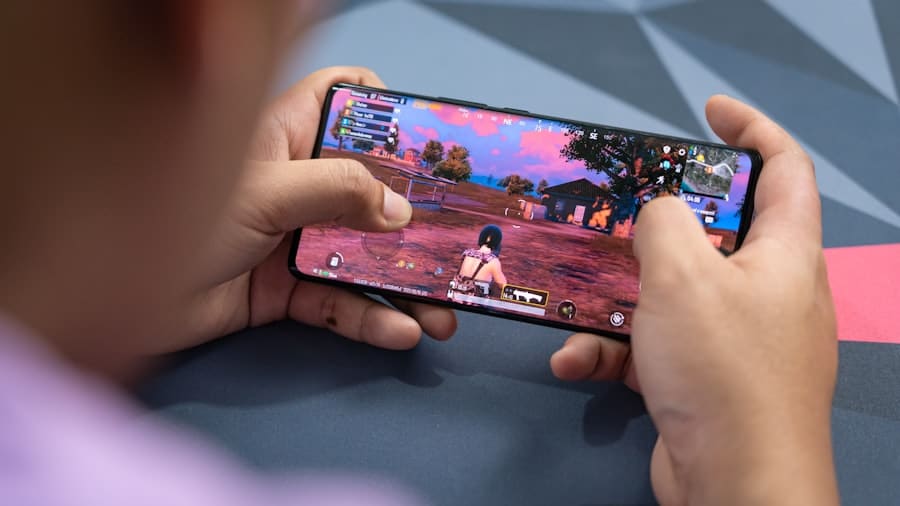The advent of mobile augmented reality (AR) games has revolutionized the educational landscape, providing innovative ways to engage students and enhance learning experiences. With the proliferation of smartphones and tablets, educators have begun to harness the potential of AR technology to create immersive learning environments. These games blend digital content with the real world, allowing students to interact with educational material in a dynamic and engaging manner.
The rise of mobile AR games in education is not merely a trend; it represents a significant shift in pedagogical approaches, moving away from traditional methods toward more interactive and experiential learning. One of the most compelling aspects of mobile AR games is their ability to capture students’ attention and motivate them to learn. By integrating game mechanics with educational content, these applications can transform mundane subjects into exciting challenges.
For instance, games like Pokémon GO have demonstrated how AR can encourage exploration and interaction with the environment, prompting players to engage with their surroundings in ways that traditional classroom settings cannot replicate. This gamification of learning not only makes education more enjoyable but also fosters a sense of curiosity and discovery among students, which is essential for effective learning.
Key Takeaways
- Mobile AR games are becoming increasingly popular in education, providing an interactive and engaging way for students to learn.
- Geography can be seamlessly incorporated into mobile AR games, allowing students to explore real-world locations and develop spatial awareness.
- Interactive learning through mobile AR games can effectively engage students and encourage collaboration and critical thinking skills.
- AR technology enables students to explore real-world locations, fostering spatial awareness and map reading skills in a dynamic and interactive way.
- Mobile AR games in geography education bridge the gap between virtual and physical geography, offering a glimpse into the future of interactive learning.
Incorporating Geography into Mobile AR Games
Geography, as a subject, lends itself particularly well to the integration of mobile AR games. The spatial nature of geography allows for the seamless blending of real-world locations with digital information, creating opportunities for students to explore and learn about their environment in an interactive way. Mobile AR games can incorporate various geographical concepts, such as topography, climate zones, and cultural landmarks, making them ideal tools for teaching geography.
By using AR technology, educators can create immersive experiences that allow students to visualize and understand complex geographical phenomena. For example, a mobile AR game could enable students to explore different ecosystems by overlaying information about flora and fauna onto their surroundings. As they walk through a local park or nature reserve, they could point their devices at specific plants or animals to receive detailed information about their habitats, behaviors, and ecological significance.
This hands-on approach not only reinforces theoretical knowledge but also encourages students to appreciate the natural world around them. Furthermore, by incorporating local geography into these games, educators can foster a sense of place and community among students, helping them connect with their environment on a deeper level.
Engaging Students with Interactive Learning

Interactive learning is at the heart of mobile AR games, providing students with opportunities to actively participate in their education rather than passively absorb information. This active engagement is crucial for fostering critical thinking skills and promoting deeper understanding of geographical concepts. Mobile AR games often incorporate challenges, puzzles, and quests that require students to apply their knowledge in real-time scenarios.
This hands-on approach not only enhances retention but also encourages students to think critically about the information they encounter. For instance, a mobile AR game designed for geography education might present students with a series of challenges related to map reading and navigation. As they progress through the game, they could be tasked with locating specific landmarks or solving geographical riddles based on clues provided in augmented reality.
By fostering an environment where students can actively engage with content, mobile AR games can significantly enhance the learning experience and promote a love for geography.
Exploring Real-World Locations Through AR Technology
One of the most exciting aspects of mobile AR games is their ability to bridge the gap between digital content and real-world locations. By allowing students to explore their surroundings through an augmented lens, these games provide unique opportunities for experiential learning. Students can visit historical sites, natural landmarks, or urban environments while interacting with digital overlays that enhance their understanding of the geographical context.
This exploration not only enriches their knowledge but also instills a sense of wonder about the world around them. For example, consider a mobile AR game that guides students through a city’s historical district. As they walk along the streets, they could use their devices to view historical images or videos that depict how the area has changed over time.
They might also encounter interactive elements that provide information about significant events or figures associated with specific locations. This immersive experience allows students to engage with history and geography in a way that textbooks cannot replicate. By exploring real-world locations through AR technology, students develop a more profound appreciation for their environment and its historical significance.
Fostering Spatial Awareness and Map Reading Skills
Spatial awareness is a critical skill in geography education, as it enables students to understand how different elements relate to one another within a given space. Mobile AR games can play a pivotal role in fostering this skill by providing interactive experiences that challenge students to navigate and interpret their surroundings effectively. Through engaging gameplay that requires map reading and spatial reasoning, students can develop essential skills that will serve them well in both academic and real-world contexts.
For instance, an AR game might require students to locate specific geographical features on a map while navigating through a park or urban area. As they search for these features, they would need to interpret map symbols, understand scale, and apply directional skills. This hands-on approach not only reinforces theoretical knowledge but also helps students build confidence in their ability to read maps and navigate unfamiliar environments.
By integrating spatial awareness training into mobile AR games, educators can equip students with valuable skills that extend beyond the classroom.
Encouraging Collaboration and Critical Thinking

Collaboration is an essential component of effective learning, and mobile AR games provide unique opportunities for students to work together toward common goals. Many AR games are designed with multiplayer features that encourage teamwork and communication among players. This collaborative aspect not only enhances the gaming experience but also fosters critical thinking as students discuss strategies and share insights while navigating challenges.
For example, an AR geography game might involve teams competing to complete various tasks related to environmental conservation or urban planning. As they collaborate to solve problems or complete missions, students must engage in discussions about geographical concepts and make decisions based on their collective knowledge. This collaborative approach not only deepens their understanding of geography but also cultivates essential skills such as communication, negotiation, and problem-solving.
By encouraging collaboration through mobile AR games, educators can create a dynamic learning environment that promotes both individual growth and teamwork.
Bridging the Gap Between Virtual and Physical Geography
Mobile AR games excel at bridging the gap between virtual content and physical geography, creating a seamless integration of digital information into real-world contexts. This unique capability allows students to experience geography in a way that transcends traditional classroom boundaries. By overlaying digital content onto physical locations, these games provide an enriched understanding of geographical concepts while encouraging exploration and discovery.
For instance, an AR game focused on climate change might allow students to visualize the impact of rising sea levels on coastal communities by superimposing data onto real-world landscapes. As they explore affected areas through their devices, they can witness firsthand the potential consequences of environmental changes. This immersive experience not only enhances their understanding of complex issues but also encourages them to think critically about solutions and actions they can take in their own communities.
By bridging the gap between virtual and physical geography, mobile AR games empower students to engage with pressing global challenges in meaningful ways.
The Future of Mobile AR Games in Geography Education
As technology continues to evolve, the future of mobile AR games in geography education looks promising. With advancements in hardware capabilities and software development, educators can expect even more sophisticated applications that enhance learning experiences. The integration of artificial intelligence (AI) and machine learning could lead to personalized learning pathways within AR games, allowing students to progress at their own pace while receiving tailored feedback based on their performance.
Moreover, as educational institutions increasingly recognize the value of experiential learning, mobile AR games are likely to become more widely adopted as effective teaching tools in geography education. The potential for cross-disciplinary applications is vast; for instance, combining geography with history or environmental science could lead to comprehensive educational experiences that address multiple facets of knowledge simultaneously. As educators continue to explore innovative ways to engage students through technology, mobile AR games will undoubtedly play a pivotal role in shaping the future of geography education.
In conclusion, the rise of mobile AR games has transformed how geography is taught and learned in educational settings. By incorporating interactive elements that engage students with real-world locations and concepts, these games foster critical skills such as spatial awareness, collaboration, and critical thinking. As technology advances and educational practices evolve, mobile AR games will continue to offer exciting opportunities for enhancing geography education and inspiring future generations of learners.
In the realm of educational technology, mobile augmented reality (AR) games have emerged as innovative tools for teaching geography in schools. These games not only engage students with interactive content but also enhance their spatial understanding and cultural awareness. A related article that delves into the broader implications of technology in children’s lives is How to Choose Your Child’s First Smartphone. This piece provides valuable insights for parents and educators on selecting appropriate technology for children, ensuring that devices like smartphones can be used effectively for educational purposes, including AR games that teach geography.
FAQs
What are mobile AR games?
Mobile AR games are games that use augmented reality technology to overlay digital elements onto the real world through a mobile device’s camera. This allows players to interact with virtual objects and characters in a real-world environment.
How do mobile AR games teach geography in schools?
Mobile AR games can teach geography in schools by incorporating real-world maps and locations into the game’s virtual environment. Players can explore different geographical locations, learn about landmarks, and understand the layout of different regions through interactive gameplay.
What are the benefits of using mobile AR games to teach geography in schools?
Using mobile AR games to teach geography in schools can make learning more engaging and interactive for students. It allows them to explore and interact with geographical concepts in a hands-on way, which can enhance their understanding and retention of the material.
Are there any specific mobile AR games designed to teach geography in schools?
Yes, there are specific mobile AR games designed to teach geography in schools, such as “World Brush” and “Geocaching.” These games incorporate geographical elements and challenges to help students learn about different locations and landmarks around the world.
How can teachers incorporate mobile AR games into their geography lessons?
Teachers can incorporate mobile AR games into their geography lessons by using them as interactive learning tools during class time or as part of a homework assignment. They can also use these games to supplement traditional teaching methods and provide students with a more immersive learning experience.

